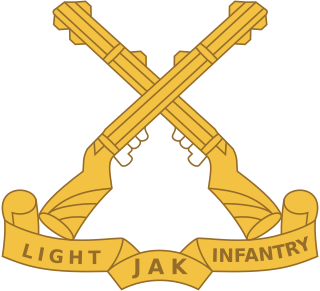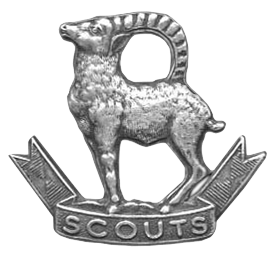
The Jammu and Kashmir Rifles is an infantry regiment of the Indian Army. Its origins lay in the Jammu and Kashmir State Forces of the princely state of Jammu and Kashmir. After the accession of the state to the Indian Union in October 1947, the State Forces came under the command of the Indian Army. They remained in the original form until 1956 when Jammu and Kashmir Constituent Assembly effectively ratified the state's accession to India. Then the State Forces became the Jammu and Kashmir Regiment of the Indian Army. In 1963, the designation was changed to Jammu and Kashmir Rifles. After the conversion, the Ladakh Scouts came under the aegis of the Regiment, where it remained until raised as a separate Regiment in 2002.

The Parachute Regiment is an airborne and special forces regiment of the Indian Army. It was raised in 1945 as part of the British Indian Army but was disbanded after World War II and was re-raised in 1952 as part of the Indian Army. Currently it consists of fifteen Special Forces, two Territorial Army and one Rashtriya Rifles battalions.

The Kumaon Regiment is one of the oldest infantry regiments of the Indian Army. The regiment traces its origins to the 18th century and has fought in every major campaign of the British Indian Army and the Indian Army, including the two world wars, and is one of the highest decorated regiments of the Indian Army.

The Madras Regiment is the oldest infantry regiment of the Indian Army, originating in the 1750s as a unit of the British East India Company. The regiment took part in numerous campaigns with the British Indian Army and the post-independence Indian Army.

The Jammu and Kashmir Light Infantry is an infantry regiment of the Indian Army. The regimental center is in Srinagar's Airport Complex at Awantipora with a winter setup near Jammu. Its regimental insignia consists of a pair of crossed rifles. The regiment mostly consists of volunteers from the state of Jammu & Kashmir and ethnic groups from the state. The Jammu and Kashmir Light Infantry is considered to be one of the most decorated regiment of the Indian army having won 1 Param Veer Chakra and 3 Ashok Chakra. Naib Subedar Chuni Lal of the 8th battalion Jammu and Kashmir Light Infantry is one of the most decorated personnel of the Indian Army.

45 Cavalry is an armoured regiment in the Armoured Corps of the Indian Army. The regiment distinguished itself in operations during the 1971 Indo-Pakistan War winning one Maha Vir Chakra.

Brigadier Kuldip Singh Chandpuri MVC, VSM was a decorated Indian Army officer. He is known for his leadership in the Battle of Longewala during the Indo-Pakistani War of 1971, for which he was awarded the Maha Vir Chakra, the second highest Indian military decoration, by the Indian government. The 1997 Hindi film Border was based on the battle, with his role played by Sunny Deol. He was a councillor in the Chandigarh Municipal Corporation from 2006 to 2011.
Lieutenant General Ranjit Singh Dyal, PVSM, MVC was an Indian Army general and an administrator. As a soldier, Ranjit Singh led the capture of the Haji Pir pass by the Indian army during the 1965 war with Pakistan. He also drew up the plans for Operation Blue Star, and served as the General-Officer-Commanding-in-Chief of the Southern Command. Later, he served as Lieutenant Governor of Puducherry and the Andaman and Nicobar Islands.
Lieutenant General Zorawar Chand 'Zoru' Bakshi PVSM, MVC, VrC, VSM was a General Officer of the Indian Army, most widely known as one of the commanders of Indo-Pakistani War of 1965. He also has the distinction of being "India's most decorated General".

The Ladakh Scouts is an infantry regiment of the Indian Army, nicknamed as the "Snow Warriors" or "Snow Leopards". The regiment specializes in mountain warfare, and its primary role is to guard India's borders in the high altitudes of the Union Territory of Ladakh.

Lieutenant General Raj Mohan Vohra, PVSM, MVC was a General Officer of the Indian Army. He was awarded the Maha Vir Chakra for his bravery and leadership in the Battle of Basantar during the Indo-Pakistani War of 1971.
Lieutenant-General Joginder Singh Gharaya MVC, KC, VSM was a highly decorated Indian Army general and the only member of the Indian Armed Forces to have won both the Maha Vir Chakra and the Kirti Chakra, the second highest wartime and peacetime Indian decorations.

The 54th Infantry Division is an Infantry division of the Indian Army. The Division was raised as an Infantry Division, but was converted into a Reorganised Amphibious Formation (RAMFOR) in 2011. It is currently the only division of the Indian Army which carries out Amphibious warfare. The division is headquartered at Secunderabad in Telangana and is a part of XXI Corps. The Division is commanded by an Officer of the rank of Major General titled General Officer Commanding (GOC).
Lieutenant General Ved Prakash Airy, MVC was an officer of the Indian Army, who served with the 3 Grenadiers. He is best known for his participation in the Battle of Basantar, one of the major battles of the Indo-Pakistani War of 1971, where he was awarded the Maha Vir Chakra, India's second highest award for gallantry in the face of the enemy.
Brigadier Vijay Kumar Berry, MVC is a retired officer of the Indian Army who served with the Parachute Regiment, and was awarded the Maha Vir Chakra, India's second highest award for gallantry in the face of the enemy. The award was made for his actions immediately after the Indo-Pakistani War of 1971, for his conspicuous gallantry and outstanding leadership while leading a company of the 4th Battalion, Parachute Regiment in an assault on a Pakistani defensive position that remained inside Indian territory. He retired from the army as a brigadier and lives in New Delhi.

Brigadier Sukhjit Singh, MVC is a former Indian Army officer who served with The Scinde Horse. He was awarded the Maha Vir Chakra, India's second highest award for gallantry, for his leadership and courage in facing the enemy during the Battle of Basantar in the Indo-Pakistani War of 1971.
Major General Chittoor Venugopal PVSM, MVC was a General Officer in the Indian Army. He was decorated with the Maha Vir Chakra for his role in the Indo-Pakistani War of 1971.
Brigadier Mohindar Lal Whig, MVC was an Indian Army officer. He served with the 5th Gorkha Rifles regiment. He was awarded the Maha Vir Chakra, India's second-highest award for his role in the Indo-Pakistani War of 1971.
Brigadier Kailash Prasad Pande, MVC was an officer in the Indian Army, who served with the Regiment of Artillery. He was awarded the Maha Vir Chakra, India's second highest award for his role in the Indo-Pakistani War of 1971.

Brigadier Narinder Singh Sandhu MVC was an Indian Army officer who was awarded the Maha Vir Chakra (MVC), the second-highest Indian military decoration, for gallantry, leadership and devotion to duty during the Indo-Pakistan War of 1971. Sandhu was commissioned into the Indian Army Armoured Corps in 1953, and participated in the Battle of Asal Uttar during the Indo-Pakistani War of 1965, and was mentioned in dispatches. He transferred to the Dogra Regiment in 1970, and it was for his performance as commanding officer of the 10th Battalion, Dogra Regiment during an assault on a fortified Pakistan Army position that he was awarded the MVC. He retired as a brigadier and was active in veterans' and gallantry award recipients' matters until his death of colorectal cancer in 2018.












